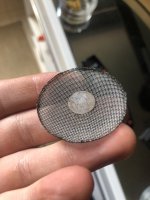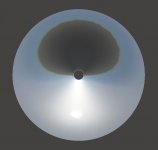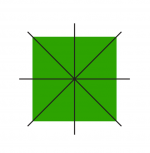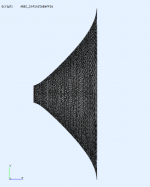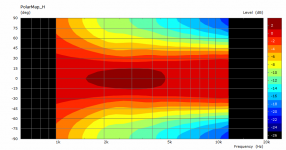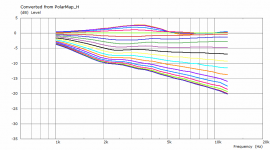I just can't help myself - aren't those measurement a bit too noisy? I would expect much smoother SPL curves, at least in the midrange. But maybe it's just because I haven't measured a dome tweeter quite in a while...
Would you mind uploading the raw IRs?
Would you mind uploading the raw IRs?
I don't quite follow here. Is the aim to reach comparable dB levels in the simulation results? Why not simply increase the value of acceleration? Now it is 1.0 m/s^2. But maybe I miss the point.I ran your file to see if there would be an easy way to set the scales in ABEC to match your Soundeasy graph. It's easy to set the scales but the response doesn't scale with it. If the model is using an LE Script an input voltage and dB output make it work but not with a constant acceleration source.
The reason is that your horizontal radius is too small to intersect the baffle plane only once - it jumps out of the baffle and dives again.
Gah, yes that's it. That is now fixed in my newest version of that waveguide (yet to be measured) but I had forgotten about it.
I just can't help myself - aren't those measurement a bit too noisy? I would expect much smoother SPL curves, at least in the midrange. But maybe it's just because I haven't measured a dome tweeter quite in a while...
Would you mind uploading the raw IRs?
Here's the raw measurements.
They are not anechoic by any means, but I got about 4.3ms before the first reflection. The responses were only moderately smoothed at 1/24 oct.
Attachments
That was what I was hoping for. It is very hard to compare graphs that use different scales for level and frequency with one another. I've been caught out myself recently wondering why something isn't working the way I thought but when looked at on the right scale the problem all but goes away 🙂I don't quite follow here. Is the aim to reach comparable dB levels in the simulation results?
You don't miss the point and changing the acceleration value would have the same result but would likely take a bit of trial and error to get the right figure. For a one off it was as easy to change it in REW.Why not simply increase the value of acceleration? Now it is 1.0 m/s^2. But maybe I miss the point.
I've been chomping at the bit to try it, but I'm so buried at work it's not even funny
Agreed, this thread is so interesting that it attracts me to get back into audio!!!
But maybe not 🙁
Mabat is to be applauded for such fine work. If only I had this kind of tool available way back when.
The same source can beam less when in waveguide,
I have said this for decades, but many people just cannot accept it.
Much earlier in this thread there was discussion about using alternative methods to solve waveguide simulations in ABEC. Namely, the ability to use symmetry (CircSym) or solve in 2D. It seemed that the consensus at the time was these methods are less accurate than a full 3D simulation. Here's my question: are they accurate enough to examine the impacts of various variables in the OS waveguide formula?
I'm thinking about putting together a DOE to examine how things like the length, throat angle, and s/q/n terms impact the directivity. I can start with a flat plane or a generic dome driver, but the current limitation by far is simulation time. Would it be a waste of time to use 2D simulation here?
I'm thinking about putting together a DOE to examine how things like the length, throat angle, and s/q/n terms impact the directivity. I can start with a flat plane or a generic dome driver, but the current limitation by far is simulation time. Would it be a waste of time to use 2D simulation here?
Not so much a waste of time but you can only simulate axisymmetric devices with cirsym, some asymmetry has been shown to beneficial.Would it be a waste of time to use 2D simulation here?
Not so much a waste of time but you can only simulate axisymmetric devices with cirsym, some asymmetry has been shown to beneficial.
Beneficial how? I was under the impression that a fully symmetrical waveguide would produce the best total response in the listening window. I'd love to learn more!
Beneficial in that the on and off axis curves are a little smoother and more similar to each other. In axisymmetric OS guides there can be an on axis dip and a small amount of asymmetry can smooth it out.
You could use cirsym to help speed up experiments into how the parameters interact.
If you read this thread from start to finish you can see where it started to where it is now and that will be more useful than someone trying to rehash it.
Making the termination smoother improves the response and mabat has settled on good figures of s, q and and n to achieve that as the default values in the demo scripts. Coverage angle length and overall size are related. When you have chosen coverage angle and set a maximum size for the guide length is decided or vice versa.
You could use cirsym to help speed up experiments into how the parameters interact.
If you read this thread from start to finish you can see where it started to where it is now and that will be more useful than someone trying to rehash it.
Making the termination smoother improves the response and mabat has settled on good figures of s, q and and n to achieve that as the default values in the demo scripts. Coverage angle length and overall size are related. When you have chosen coverage angle and set a maximum size for the guide length is decided or vice versa.
In case of the H1212 waveguide, there's obviously something happening above 10 kHz that is not covered in the model. I wonder what that could be and whether we are able to include it. That would be interesting to find out. So is it something about the hard vs. soft dome?
The (unmodified) SEAS 27TBFC (H1212) comes with a clear plastic disc below the grid, which helps to improve dispersion characteristics.
Or, to quote the designer:
"The plastic lense or diffusor is there to lift the frequency response between 15 and 20kHz."
Attachments
Last edited:
Is foam then, like internal cabinet damping materials, significantly less effective when used at a pressure antinode?foam has density and resists air flow. That's where the damping comes from.
Beneficial how? I was under the impression that a fully symmetrical waveguide would produce the best total response in the listening window. I'd love to learn more!
You mean axisymmetrical (i.e. 'round') waveguide?
A symmetrical waveguide would be square, for instance 60 x 60°.
Attachments
Last edited:
An axisymmetrical waveguide incorporates at least one (major) advantage: there's no pattern flip.
Theoretically, it should also preserve the shape of the wavefront best.
Finally, it's relatively easy to manufacture.
Theoretically, it should also preserve the shape of the wavefront best.
Finally, it's relatively easy to manufacture.
Last edited:
Actually, I've been playing around with CircSym for a while (again) and it's really the way to go for axisymmetric devices. It can be made precise enough by increasing the mesh resolution greatly - as I realized later, there's absolutely no problem going to 50 kHz or more, it still solves even big waveguides in minutes without a glitch up to 20 kHz (something unthinkable with a full 3D sim in ABEC). As I also intend to make a really good big free standing axisymmetric waveguide, CircSym is almost a must - currently I'm implementing the option.Much earlier in this thread there was discussion about using alternative methods to solve waveguide simulations in ABEC. Namely, the ability to use symmetry (CircSym) or solve in 2D. It seemed that the consensus at the time was these methods are less accurate than a full 3D simulation. Here's my question: are they accurate enough to examine the impacts of various variables in the OS waveguide formula?
I'm thinking about putting together a DOE to examine how things like the length, throat angle, and s/q/n terms impact the directivity. I can start with a flat plane or a generic dome driver, but the current limitation by far is simulation time. Would it be a waste of time to use 2D simulation here?
For an experiment you suggest, it would be the perfect method.
Last edited:
Such "diffusers" can be added and experimented with easily via the source definition script now.The (unmodified) SEAS 27TBFC (H1212) comes with a clear plastic disc below the grid, ...
I hoped you would 🙂Agreed, this thread is so interesting that it attracts me to get back into audio!!!
BTW, these are the BEM results for the "demo1" example included in the Ath package (OS waveguide ⌀254 x 94 mm in an IB) - for a demo I wanted something that solves in a short time, this one takes 5 minutes on an ordinary PC.
Maybe it could be still improved as axisymmetric of the same size, I don't know, I've only put together some numbers.
Maybe it could be still improved as axisymmetric of the same size, I don't know, I've only put together some numbers.
Attachments
Last edited:
- Home
- Loudspeakers
- Multi-Way
- Acoustic Horn Design – The Easy Way (Ath4)
